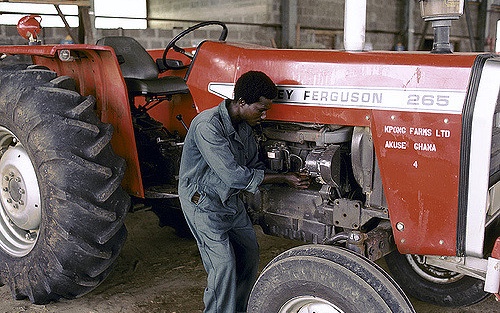Agricultural mechanization has many benefits for developing countries: It raises productivity and lowers costs, makes supply chains more efficient, and is more environmentally friendly than traditional farming techniques. Mechanization is key for Africa’s agricultural transformation, which must adapt to the needs of urbanizing populations, increased food demand, and rising rural wages.
But that process has not been smooth for Africa. Despite the recent agricultural intensification trend, a combination of market failures and detrimental government interventions have prevented the supply of mechanization options in African countries from meeting demand. Asia, meanwhile, has largely achieved this balance, with tremendous mechanization growth across much of the continent. Africa can benefit from Asia’s mechanization techniques and success stories—but the exchange of knowledge has so far been limited by the lack of empirical information about the development of mechanization in both regions.
In a new IFPRI book, An Evolving Paradigm of Agricultural Mechanization Development: How Much Can Africa Learn from Asia?, editors Xinshen Diao, Hiroyuki Takeshima, and Xiaobo Zhang aim to fill this knowledge gap. The book assesses and compares the divergent patterns of the Asian and African experiences with the adoption of tractors, combine harvesters, and other farm machinery. It assesses Africa’s market and government failures, and identifies challenges specific to Africa and their policy implications. The book includes thirteen case studies documenting the differences in mechanization processes across regions.
In Asia, the case studies include Bangladesh, China, India, Myanmar, Nepal, Sri Lanka, Thailand, and Viet Nam. Overall, these show that the physical and market conditions in Asian countries favored the development of machine-hiring markets where smaller farmers are able to rent machines for tilling, harvesting, and other activities, minimizing the economic burden of replacing manual labor with machine labor. Rising rural incomes across the continent combined with a low machinery costs have even made buying agricultural machines affordable for some small- and medium-scale farmers, allowing them to become service providers in the hiring market and earn income. In addition, subsidized credit was widely available in several countries, allowing farmers to use their land as collateral to acquire machines. The book found that in general, government policies and public goods, such as reducing import tariffs on agricultural machinery, investment in agricultural research to improve yields, and investment in rural roads, have contributed to the success of mechanization development in most Asian countries.
In Africa, the book examines the cases of Ethiopia, Ghana, Kenya, Nigeria, and Tanzania. It finds that both demand and supply factors have suppressed mechanization. On the demand side, slow yield growth among most African crops has limited the benefits that mechanization could provide. Most African countries have not experienced an Asian-type Green Revolution, and adoption rates of improved seeds, fertilizers, pesticides, and other inputs remain relatively low. Without these gains in intensification and yields, many farmers lack incentive to invest in mechanizing labor.
Where demand for mechanization has emerged in Africa, it is often stifled by market failures in supply. Not only do African nations lack large-scale manufacturing of agricultural machinery, but distance from those manufacturers and low overall demand drive up the costs of importing machinery. African banks are reluctant to lend to farmers, due to the difficulty of using land as collateral and doubts about profitability. Such factors make mechanization financially difficult or unfeasible for many African farmers.
While urbanization and economic growth in Africa have helped drive a shift of labor out of agriculture, these structural changes have not yet sparked an overall move towards agricultural mechanization, or broader rural transformation. The book provides several policy recommendations to guide African governments and other stakeholders on improving mechanization processes. These go beyond just increasing subsidies, which was only one aspect of Asia’s success, suggesting how to create an environment that makes it economically feasible for more farmers to adopt mechanization.
Recommendations include increasing the flow of machinery imports by lowering import taxes, investing in more research and development projects such as soil mapping to fill mechanization knowledge gaps, and strengthening local institutional partnerships to facilitate more productive knowledge sharing. The book also suggests that African countries prioritize market-led hiring services and identify country-specific technologies that governments can specifically promote and offer extension and training programs on.
The most effective mechanization solutions will be highly localized, and so understanding Asia’s lessons is only the first step to addressing these complex challenges. Perhaps the most productive knowledge exchanges will take place between African countries and sectors as they gain more localized knowledge by supporting local research projects, conferences, and other approaches. National policy makers and the African development community can adapt the knowledge provided in An Evolving Paradigm of Agricultural Mechanization Development: How Much Can Africa Learn from Asia? to local contexts and use it as a foundation for further research.
Francesca Edralin is an IFPRI Communications Intern.
Work on this book was undertaken as part of the IFPRI-led CGIAR Research Program on Policies, Institutions, and Markets (PIM), and financially supported by PIM, USAID, and ReSAKSS-Asia.







